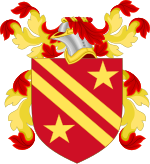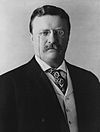| Charles Bonaparte | |
|---|---|
 | |
| 46th United States Attorney General | |
| In office December 17, 1906 – March 4, 1909 | |
| President | Theodore Roosevelt |
| Preceded by | William Moody |
| Succeeded by | George W. Wickersham |
| 37th United States Secretary of the Navy | |
| In office July 1, 1905 – December 16, 1906 | |
| President | Theodore Roosevelt |
| Preceded by | Paul Morton |
| Succeeded by | Victor H. Metcalf |
| Personal details | |
| Born | Charles Joseph Bonaparte (1851-06-09)June 9, 1851 Baltimore, Maryland, U.S. |
| Died | June 28, 1921(1921-06-28) (aged 70) Baltimore County, Maryland, U.S. |
| Resting place | Loudon Park Cemetery |
| Political party | Republican |
| Spouse |
Ellen Channing Day (m. 1875) |
| Relatives | Jérôme Napoléon Bonaparte (father) Susan May Williams (mother) See Bonaparte family |
| Education | Harvard University (BA, LLB) |
Charles Joseph Bonaparte (/ˈboʊnəpɑːrt/ BOH-nə-part; June 9, 1851 – June 28, 1921) was an American lawyer and political activist for progressive and liberal causes of French noble descent. Originally from Baltimore, Maryland, he served in the cabinet of the 26th U.S. president, Theodore Roosevelt.
He was a descendant of the House of Bonaparte. His grandfather was Jérôme Bonaparte, brother of Emperor Napoleon.
Bonaparte was the U.S. Secretary of the Navy and later the U.S. Attorney General. During his tenure as Attorney General, he created the Bureau of Investigation (now the FBI). Bonaparte was one of the founders, and for a time the president, of the National Municipal League. He was also a long-time activist for the rights of black residents of his native city of Baltimore.
Early life and education

Bonaparte was born in Baltimore, Maryland, on June 9, 1851, the son of Jérôme ("Bo") Napoleon Bonaparte (1805–1870), and Susan May Williams (1812–1881), from whom the American line of the Bonaparte family descended, and a grandson of Jérôme Bonaparte, King of Westphalia, the youngest brother of French emperor Napoleon. However, the American Bonapartes were not considered part of the dynasty and never used any titles.
Bonaparte graduated from Harvard College in Cambridge, Massachusetts in 1871 and lived in Grays Hall during his freshman year. He then continued to Harvard Law School, where he later served as a university overseer. He practiced law in Baltimore and became prominent in municipal and national reform movements.
Career
In 1899, Bonaparte was the keynote speaker for the first graduating class of the Roman Catholic women's institution run by the Order of the School Sisters of Notre Dame, the College of Notre Dame of Maryland (now Notre Dame of Maryland University). He spoke on "The Significance of the Bachelor's Degree".

Bonaparte lived in a townhouse in the north Baltimore neighborhood of Mount Vernon-Belvedere and had a country estate in suburban Baltimore County, Maryland, which surrounds the city on the west, north and east. His home, Bella Vista, was designed by the architects James Bosley Noel Wyatt (1847–1926) and William G. Nolting (1866–1940), in the prominent local architectural partnership firm of Wyatt & Nolting in 1896. It lies east of the Harford Road (Maryland Route 147) in an area called Glen Arm. The house was not electrified since Bonaparte refused to have electricity or telegraph lines installed from a dislike of technology, verified by his use of horse-drawn coach until his death in the early 1920s.
Politics
Bonaparte was a founder of the Reform League of Baltimore, organized in 1885. The League gained a clean sweep of municipal elections in 1895: long-time minority progressive liberal Republicans ousted many Democratic machine politicians in heavily Democratic wards. The League men governed with clean hands for a brief time, providing a certain amount of efficient municipal government.
Bonaparte was a member of the Board of Indian Commissioners from 1902 to 1904, chairman of the National Civil Service Reform League in 1904, and appointed a trustee of Catholic University of America in Washington, D.C.
In the 1904 United States presidential election, Bonaparte was named one of eight Republican candidates for presidential elector. Maryland at this time chose electors individually, in an at-large election. In an unusual result, Bonaparte got the most votes of any candidate, narrowly outpolling the eight Democrat candidates, who narrowly outpolled the other seven Republicans. Thus Bonaparte was the only Republican elector from Maryland, which may have reflected his personal reputation.
In 1905, President Theodore Roosevelt appointed Bonaparte Secretary of the Navy. In 1906 Bonaparte moved to the office of Attorney General, which he held until the end of Roosevelt's term. He was active in suits brought against the trusts and initiated the suit which broke up the monopolistic American Tobacco Company. He became known as "Charlie, the Crook Chaser". In 1908, Bonaparte established a Bureau of Investigation (BOI) within the Department of Justice, under the direction of the Attorney General himself. The BOI later became the FBI.
In the 1912 United States presidential election, Bonaparte supported the Bull Moose party of Theodore Roosevelt.
Personal life
On September 1, 1875, Bonaparte married Ellen Channing Day (1852–1924), daughter of attorney Thomas Mills Day and Anna Jones Dunn. They had no children.
In 1903, he was awarded the Laetare Medal by the University of Notre Dame, the oldest and most prestigious award for American Catholics.
Death
Bonaparte died in Bella Vista at age 70 and is interred at southwest Baltimore's landmark Loudon Park Cemetery. He died of "Saint Vitus' dance", a nonspecific term used at the time to refer to chorea. A nearby street in Baltimore County bears the name of Bonaparte Avenue.
After Bonaparte's death, the house was later owned by bootleggers Peter and Michael Kelly. After they left, it was destroyed in a fire caused by faulty wiring on January 20, 1933. The site was replaced by a poured concrete mansion, but a large carriage house, dating back to 1896, is still on the estate.
Sources
- Bishop, Joseph Bucklin (1922). Charles Joseph Bonaparte: His Life and Public Services. New York: C. Scribner's Sons. LCCN 22024561. OCLC 3178193.
- Goldman, Eric F. (1943). Charles J. Bonaparte: Patrician Reformer, His Earlier Career. Baltimore: Johns Hopkins Press. LCCN 43014187. OCLC 639278.
References
- McLynn, Frank (1998). Napoleon. Pimlico. p. 2. ISBN 0-7126-6247-2. ASIN 0712662472.
- Annual Report of the Maryland State Bar Association. Vol. 26. Maryland State Bar Association. 1921. pp. 43–45.
- "FBI — 1935 Washington Star Article". Fbi.gov. Archived from the original on April 11, 2010. Retrieved August 16, 2013.
- Shahab Keshavarz. "Charles J. Bonaparte". Italian Historical Society of America. Archived from the original on April 8, 2014. Retrieved August 16, 2013.
- "Baltimore's Civil Rights Heritage (1885–1929)". baltimoreheritage.github.io. Retrieved February 20, 2019.
White Republican party leaders, including prominent Baltimore lawyer Charles J. Bonaparte, also played a role in rallying opposition to these proposals. Historian Jane L. Phelps noted Bonaparte's opposition to the Poe and Strauss Amendments in 1905 and 1908 (Phelps, "Charles J. Bonaparte and Negro Suffrage in Maryland.") <56>.
- ^ Kelly, Jacques. "Houses – Bella Vista". Baltimore County Public Library Legacy Web. Archived from the original on September 30, 2011. Retrieved October 12, 2011.
- Don Bloch (August 18, 1935). "Bonaparte Founded G-Men". FBI. Archived from the original on May 10, 2012. Retrieved June 6, 2012.
- Too Close to Call: Presidential Electors and Elections in Maryland, featuring the Presidential Election of 1904. Archives of Maryland Documents for the Classroom.
- "1904 Presidential Electors - Maryland". Dave Leip's Atlas of U.S. Presidential Elections.
- Charles Joseph Bonaparte, his life and public services. pp. 256–267.
- "Recipients | The Laetare Medal". University of Notre Dame. Retrieved August 2, 2020.
External links
- Works by or about Charles Joseph Bonaparte at the Internet Archive
- Charles Joseph Bonaparte at Find a Grave
- If Walls Could Talk: Chateau Bonaparte on K Street – Ghosts of D.C. blog post on the Bonaparte residence in Washington, DC
| Political offices | ||
|---|---|---|
| Preceded byPaul Morton | United States Secretary of the Navy 1905–1906 |
Succeeded byVictor H. Metcalf |
| Legal offices | ||
| Preceded byWilliam H. Moody | United States Attorney General 1906–1909 |
Succeeded byGeorge W. Wickersham |
| United States attorneys general | ||
|---|---|---|
|  | |
| Cabinet of President Theodore Roosevelt (1901–1909) | ||
|---|---|---|
| Secretary of State |
|  |
| Secretary of the Treasury |
| |
| Secretary of War |
| |
| Attorney General |
| |
| Postmaster General |
| |
| Secretary of the Navy |
| |
| Secretary of the Interior |
| |
| Secretary of Agriculture |
| |
| Secretary of Commerce and Labor |
| |
| Special prosecutors and independent counsels of the U.S. | |
|---|---|
|
| Bonaparte family | ||
|---|---|---|
| 1st generation |  | |
| 2nd generation |
| |
| 3rd generation |
| |
| 4th generation | ||
| 5th generation | ||
| 6th generation | ||
- 1851 births
- 1921 deaths
- 20th-century American politicians
- American people of Corsican descent
- American Roman Catholics
- Catholic University of America trustees
- Civil service reform in the United States
- Harvard College alumni
- Harvard Law School alumni
- Laetare Medal recipients
- Lawyers from Baltimore
- Maryland Republicans
- Patterson family of Maryland
- People of Tuscan descent
- Princes of France (Bonaparte)
- Special prosecutors
- Theodore Roosevelt administration cabinet members
- Attorneys general of the United States
- United States secretaries of the navy
- College honor society founders


